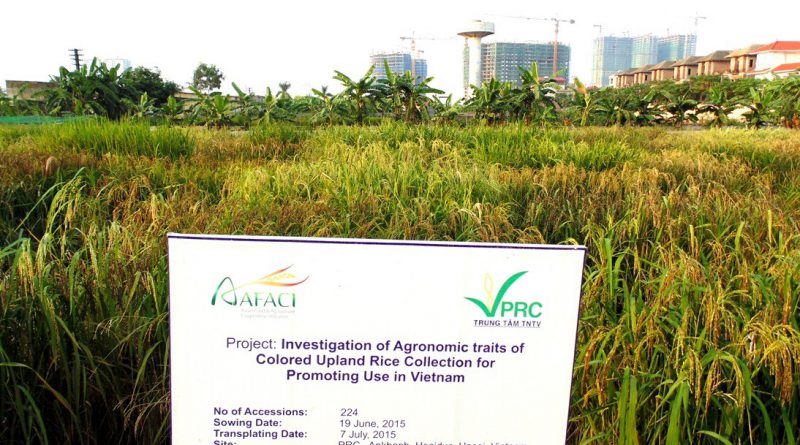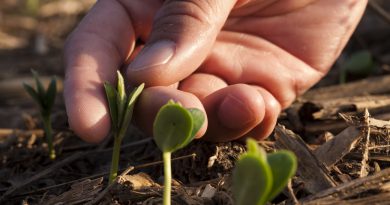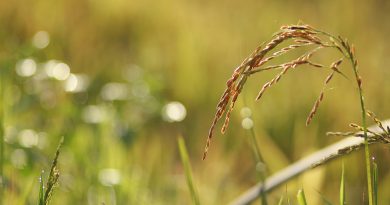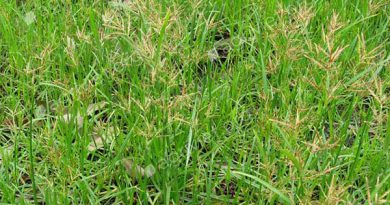Status of the Project : Investigation of Agronomical Traits of Colored Upland Rice Collection for Promoting Use in Vietnam
Nguyen Khac Quynh, Nguyen Tien Hung, Hoang Thi Hai, Doi Hong
Hanh, La Tuan Nghia , Nguyen Thi Quyen and Nguyen Thi Tuyet.
1. Introduction
In the world, nearly 100 million people now live on upland rice and two-thirds of the upland rice area is planted by Asia countries such as Bangladesh, Cambodia, China, India, Indonesia, Myanmar, Thailand, Lao and Vietnam. Recently, In Vietnam due to food security is improved remarkably and consequently, the area of upland rice was declined from 450,000 ha in late 1990s down to 130,000 ha in 2009. Nowadays, food security in Vietnam is not big problem as it in the past but upland rice still keep very important role, not only for food security but also traditional customs and practices for ethnic peoples living in mountainous areas. Therefore conservation and sustainable exploitation of upland rice need to be paid much more attention.
National Plant Resources Center, VAAS is conserving about 3000 upland rice accessions that collected from 8 Agro-ecological areas of Vietnam. These precious genetic resources have been provided by 32/54 ethnic minorities in Vietnam, some of them is heirloom varieties. These landraces need to be evaluated, selected and introduced back to production, especially climate change becomes as the big problem to Vietnam now. The results of exploration and collecting from the first phase Project supported by AFACI revealed that among upland rice resources, colored upland rice ones is paid very much attention by ethnic peoples with 15-20% their varieties kept as heirloom ones. Besides using colored rice as normal foods, rice wines they are used as functional foods and sometime as medicines such as treating cold sweating, enuresis disease in children or bowel disease. Recently, demand for colored rice as functional food rising, mainly red and purple rice in big cities that facilitating a chance for upland people produce more colored rice to meet this market. Therefore, the Project “Investigation of Agronomical Traits of Colored Upland Rice Collection for Promoting Use in Vietnam” supported by AFACI is very significant and essential.
2. Project activities and methodologies
– Evaluation of agronomic traits based on the IRRI guide such as Seedling vigor, Leaf senescence , Culm strength, Maturity , Panicle exsertion, Panicle threshability, Phenotypic acceptability, Plant height, Spikelet fertility, Tillering ability, Grain yield.
– Collection evaluation of 200 accessions based on agronomic traits in 2015 and choose 30 elites for trials in 2016.
– Using DNA marker technique (SSR) to analyze genetic diversity of selected 30 accessions; – Evaluation of drought tolerance in pots to selected accessions (3 repeats)
– A trial of 30 elites with 3 repeats evaluated in 2016 and then choose 5-7 best ones for demonstrations in 2017.
– Non-repeat demonstrations will be conducted in three ecological zones presented by Nghe An, Hoa Binh and Quang Ninh in 2017.
– All data, pictures of accessions is recorded, documented into a catalogue and then published in 2016.
– One research paper related colored upland rice in Vietnam will be published by a prestigious journal inVietnam or Korea
– Yearly send staffs to participate in the workshops/trainings organized by AFACI and organize local trainings/workshop with supported by AFACI.
3. Project achievements in 2015
– Based on data and information of specific characters/traits of colored upland rice accessions conserved at the Seed Genebank, there were 224 colored UR ones (117 purple, 19 variable purple, 73 red and 6 brown) chosen for regenerating, evaluating in 2015, but due to damage by rats there were 215 accessions harvested at the end. Investigation procedure was based on agronomic traits of rice and as a result, there have been elite 30 accessions selected (8 red and 22 purple ones) for evaluation in 2016 (Table 1).

– There were 500 rice accessions multiplied, cleaned, packed and sent to the RDA genbank on December, 2015
– At the end of 2015, we attended two exhibitions in Quang Ninh and Thanh Hoa Cities where the results and product (Black rice) of AFACI project were shown to the public. The Provincial officers visited and paid much attention to black rice.
– In summer season of 2015, in cooperation with the Dong Trieu National Farm in Quang Ninh Province, The PGR Data and Information Department implemented the project: Promoting black rice production and processing in Dong Trieu District. Two hectares of black rice variety (Selected from the 1st AFACI Project namely “Cam Tuyen”) were sown and finally gave a high yield of 4.5 ton/ha. All product of project were processed, packed and consumed in Quang Ninh and Hanoi markets and introduced to exhibitions.
– During 2015, there were 2 researcher of NPRC sent to the Training Workshop organized by AFACI in Korea. During the time of the AFACI Basic Agriculture Workshop in Hanoi, from 18-22 August 2015, Scientists of AFACI IMPGR family visited the National Plant Resources Center and the experiment of project in NPRC. From 26-27, December, 2015 a local training workshop for 34 researchers of NPRC held in Hanoi, Vietnam with supported by the AFACI expert.
Table 1: The result of evaluation on colored upland rice collection in 2015
| Agronomic Traits | Frequency of Accessions in Scales | Selected percent (%) | |
| Total | Selected | ||
| 1. Tillering ability | |||
| Very high | 0 | 0 | 0.00 |
| good | 0 | 0 | 0.00 |
| medium | 13 | 1 | 7.69 |
| low | 170 | 26 | 15.29 |
| Very low | 32 | 3 | 9.38 |
| Subtotal | 215 | 30 | 13.95 |
| 2. Culm strength | |||
| Strong | 36 | 7 | 19.44 |
| Moderate strong | 80 | 16 | 20.00 |
| Intermediate | 83 | 6 | 7.23 |
| Weak | 14 | 0 | 8.43 |
| Very weak | 2 | 0 | 0.00 |
| Subtotal | 215 | 30 | 13.95 |
| 3. Plant height | |||
| Semi-dwarf | 8 | 3 | 37.50 |
| Intermediate | 1 | 0 | 0.00 |
| Tall | 206 | 27 | 13.11 |
| Subtotal | 215 | 30 | 13.95 |
| 4. Leaf senescence | |||
| Late and slow | 22 | 2 | 9.09 |
| intermediate | 170 | 26 | 15.29 |
| Early and fast | 23 | 2 | 8.70 |
| Subtotal | 215 | 30 | 13.95 |
| 5. Panicle exsertion | |||
| Well exserted | 162 | 18 | 11.11 |
| Moderate well | 47 | 10 | 21.28 |
| Just exserted | 4 | 2 | 50.00 |
| Partly exserted | 2 | 0 | 0.00 |
| Enclosed | 0 | 0 | 0.00 |
| Subtotal | 215 | 30 | 13.95 |
| 6. Panicle threshability | |||
| Difficult | 7 | 1 | 14.29 |
| Moderate Dif. | 67 | 10 | 14.93 |
| Intermediate | 109 | 14 | 12.84 |
| Loose | 30 | 5 | 16.67 |
| Easy | 2 | 0 | 0.00 |
| Subtotal | 215 | 30 | 13.95 |
| 7. Spikelet fertility | |||
| High fertile | 51 | 6 | 11.76 |
| Fertile | 137 | 21 | 15.33 |
| Partly sterile | 24 | 3 | 12.50 |
| High sterile | 3 | 0 | 0.00 |
| 0% | 0 | 0 | 0.00 |
| Subtotal | 215 | 30 | 13.95 |
| 8. Phenotypic acceptability | |||
| Excellent | 77 | 20 | 25.97 |
| Good | 15 | 10 | 66.67 |
| fair | 120 | 0 | 0.00 |
| poor | 3 | 0 | 0.00 |
| unacceptable | 0 | 0 | 0.00 |
| Subtotal | 215 | 30 | 13.95 |
| 9. Maturity | |||
| 110-120 days | 76 | 17 | 25.76 |
| 130-140 days | 116 | 13 | 15.85 |
| > 150 days | 23 | 0 | 0.00 |
| Subtotal | 215 | 30 | 13.95 |
4. Status report of the 2nd year of the project
– At present, the evaluating experiment of 30 colored upland rice accessions with 3 repeats has been carried out in suburb of Hanoi. Evaluating agronomic traits of these accessions is implemented weekly. The anti-rat nylon wall has been set up. All accessions are performing well up to now. The plan for activities in 2016 is shown at the Table 2 below.
– A research paper related results from the 1st phase project has been printed in VAAS’s book and presented at the National Second Crop Workshop in Can Tho City, Vietnam from 11-12 August, 2016.
– There have been 01 PhD and 01 MSc. students of NPRC registered to participate as researchers of project so that they can be used data and information of project for their thesis.
– From 18-27 April, 2016 there were two researchers of NPRC participated in the 4th AFACI International Training Workshop on GMS in Korea.
Table 2: Future plan for 2016

5. Future plan for the project
For 2016
– Conduct experiments (3 repeats) for evaluating agronomic traits of 30 accessions of color upland rice selected in 2015 including trials of drought resistance so that chose out 5-7 best accessions for demonstration in 2017
– Apply DNA marker technique (SSR) to evaluate genetic diversity of 30 colored upland rice selected in 2015.
– Analyze content of anthocyanins of 5-7 colored upland rice selected in 2016
– Continue sending PGR materials of safety backup to the RDA genbank
– Publish a catalogue of 215 accessions of color upland rice
– Participate in training, workshops organized by AFACI and organize local trainings for upland rice growing farmers, attend exhibition to show results of the project to the public
For 2017
– There will be 5-7 best accessions of color upland rice demonstrated at 3 sites of 3 provinces, namely Nghean, Hoabinh and Quangninh which represent for 3 ecological regions in the Northern Vietnam. The Local farmers will be invited as stakeholders of project. They will be involved in evaluating colored upland rice together scientists and local extension workers.
– Continue sending PGR material of safety backup to the RDA genebank
– Send staff to participate in trainings, workshops organized by AFACI and organize a final workshop of the project at the end of 2017.

Table 3: Action plan for 2016-2017

– Date of signing of LOA: 11th March, 2014 between Rural Development Administration, Korea and Vietnam Academy of Agricultural Sciences.6. Plan of PGR Duplication to the World Seed Vault at Suwon, Korea
– Since 2014 to 2015, Vietnam has sent 10.000 rice accessions in total to the World Seed Vault at Suwon, Korea for duplication. This year there have been 500 accessions of rice propagated and they will be sent to the World Seed Vault at Suwon, Korea at the end of this year.
7. Gaps, comments and recommendations
– The yellow stem borer is still big problem to experiment of upland rice, especially at the heading stage. It should be observed and controlled rigorously.
– The birds are the second problem, especially the sparrow can destroy rice field at the ripening time. It should be covered by fine nets
– Lack of net house for evaluating drought resistance
(Paper presented at the Basic Agriculture workshop in Nepal from 6-10 Sept., 2016)



